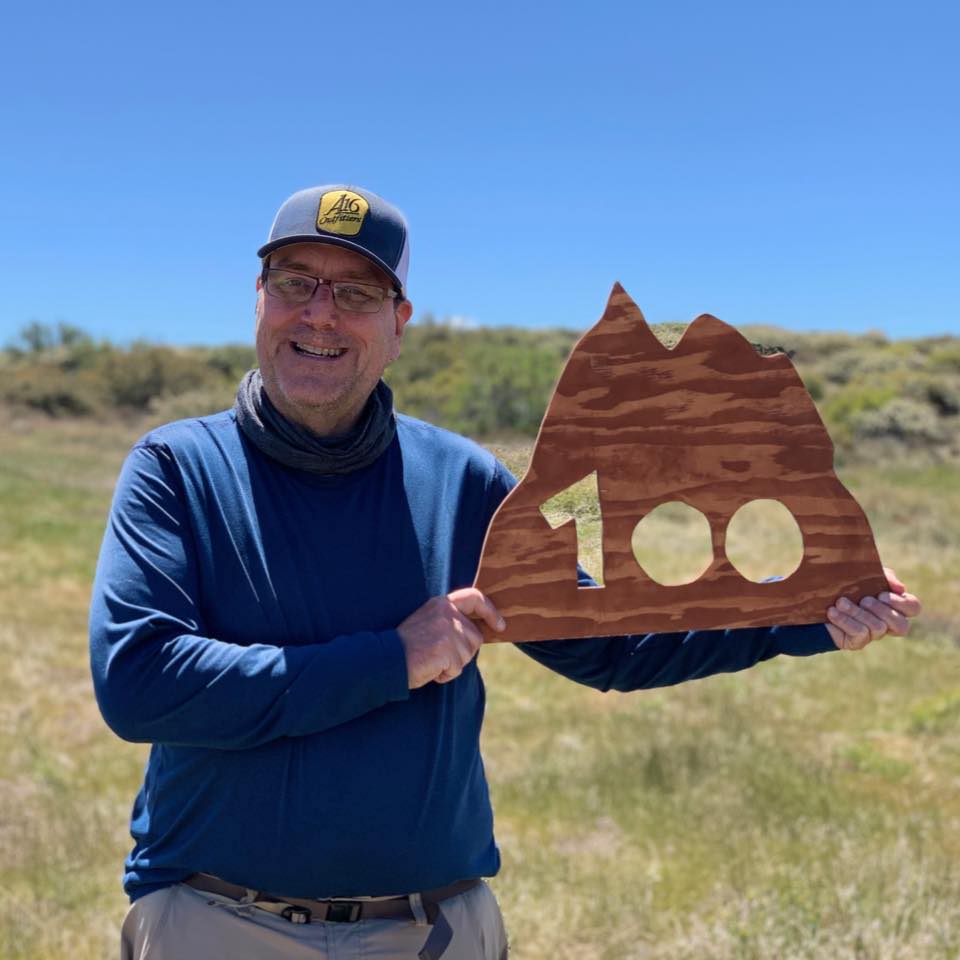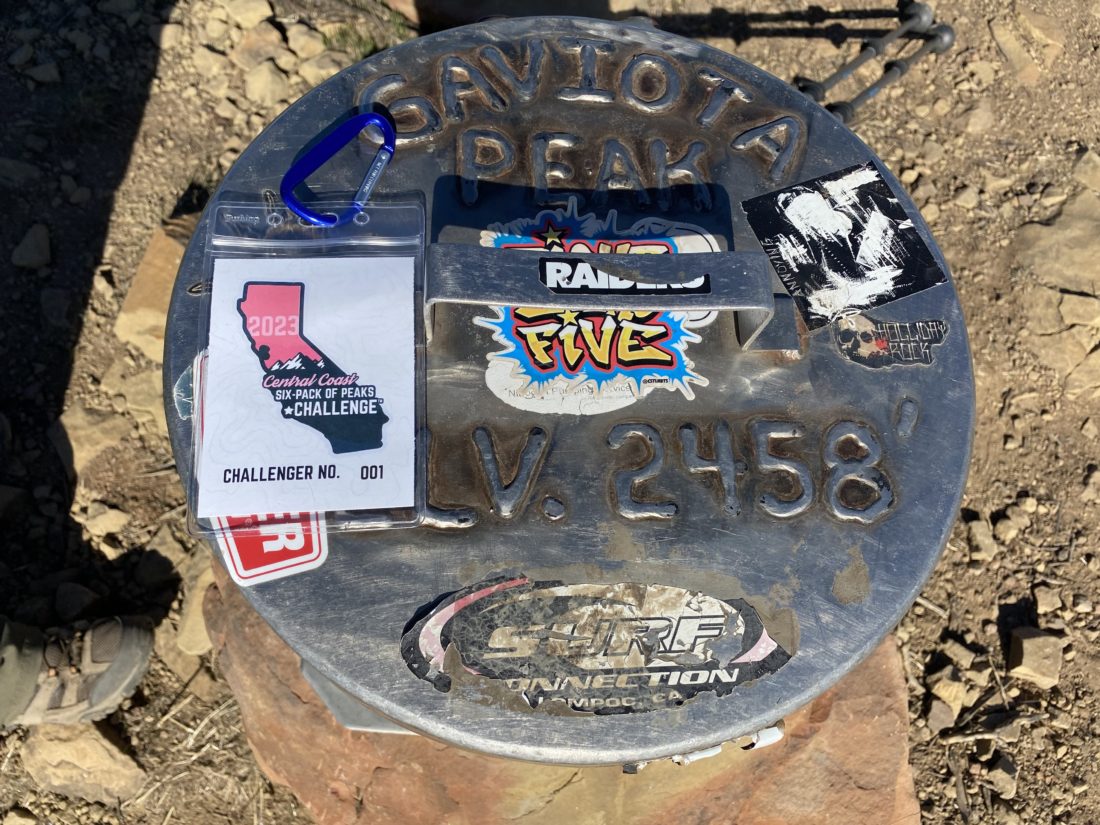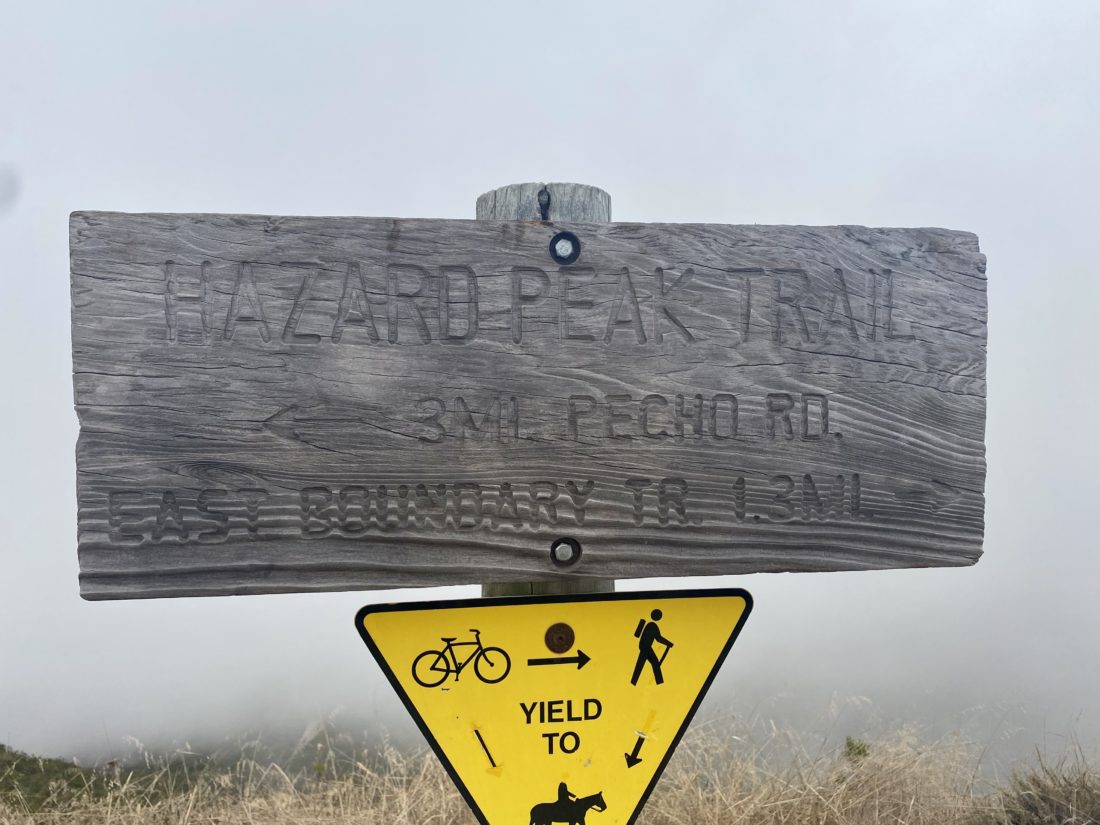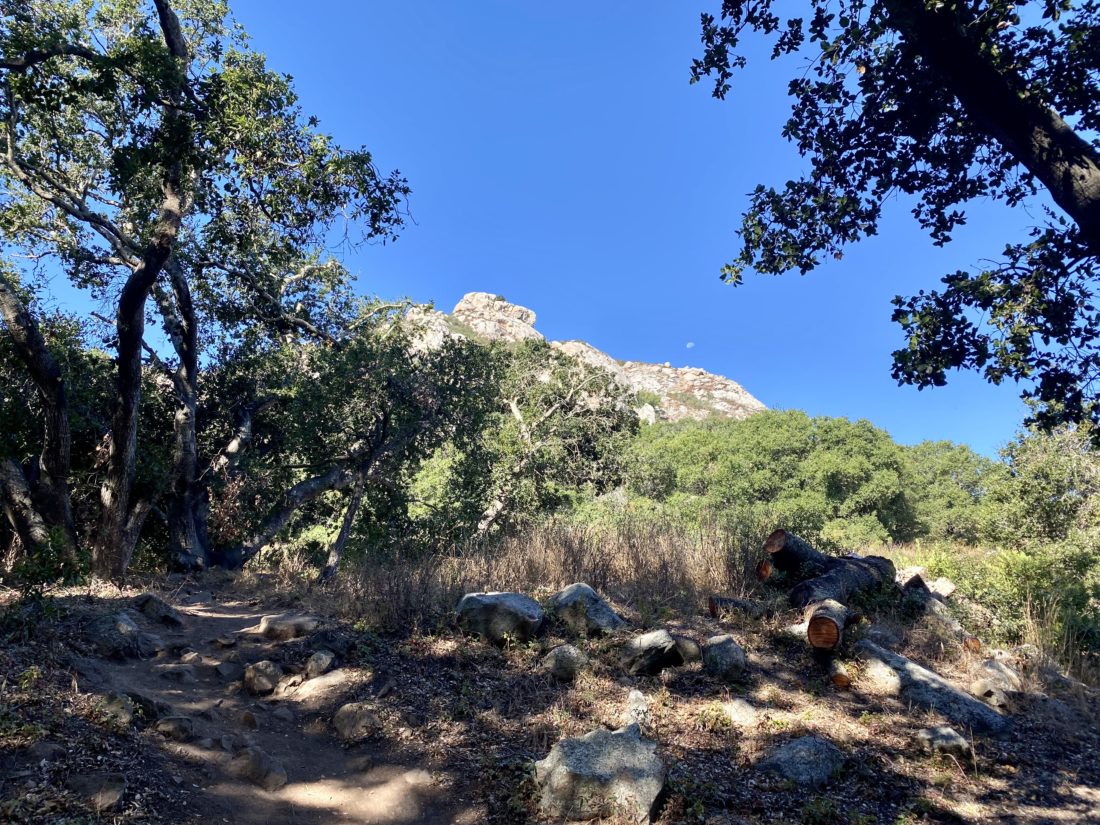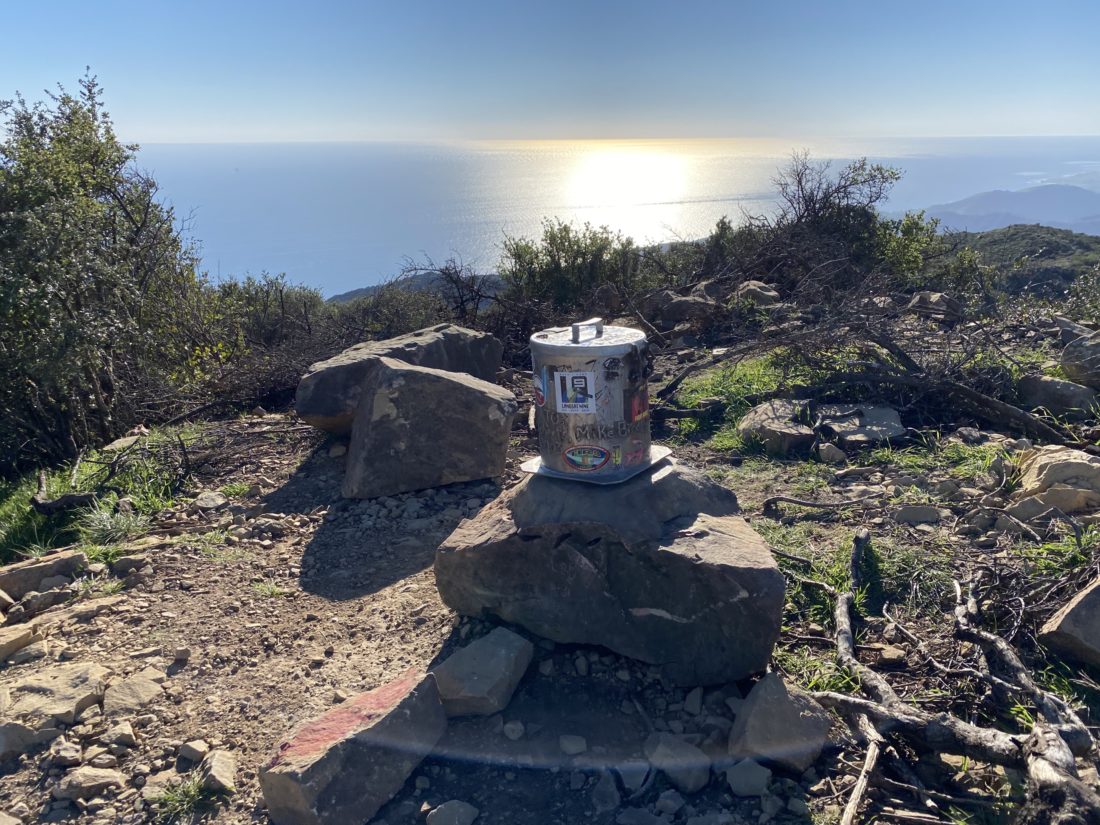I woke to discover that a trash panda had gotten into my cooler and enjoyed the Snickers bar I had wanted to take on the hike. After cleaning up the minor mess, I had breakfast and prepared to head out. Between the overcast skies and being in a canyon, I had actually slept in rather than waking at dawn’s first light. That actually was fine, as most of the hike is due east, so not staring directly into the sun was fine by me. There are several different trailheads to choose from; one is very close to my actual campsite, but that would have added about 2 miles to an already long hike. There is another trailhead near the Spooner Ranch house, but I did not want to park the car there or make the walk down to it. In the end, I parked at the Valencia Peak trailhead. This peak is on the Sierra Club Lower Peaks Committee list, so I was interested in possibly climbing it, but only if I felt up to it upon my return from Alan Peak. As I gathered my gear, a nice three-point buck strolled down the road. The sun was high enough that my hat shaded my eyes, and I set off. The trail starts out mellow for the first mile until it reaches the junction with the Badger Trail and the New Oats Peak Trail. Since I wanted some recon on Valencia Peak, I started working my way up toward it. After a couple of switchbacks, the trail stuck to following the ridgeline. Evidence of geological tilt was very apparent. I reached the turn-off to the summit and continued on. Unfortunately, the trail lost 200+ feet of elevation, and I was not happy. I knew this hike had a lot of ups and downs, so extra gain/loss was something I did not want. This was something I was going to need to factor in for my return.
The trail now linked back up with the Oats Peak Trail and pushed eastward and upward. I stared off along the ridgeline ahead of me, trying to identify which bump was actually Oats Peak and my first planned rest stop. A trail sign said ½ mile to the summit, but of course, there was a minor bump along the way to cross first. Thankfully, this one did have a side route, so I saved about 100 feet of climbing. Once on Oats, a nice double-sided bench called to me to come sit and take a rest. The benchmark was clearly visible atop a metal pole. While I enjoyed a snack and some fluids, three other hikers joined me. They were from Cal Poly SLO’s hiking club, and doing a loop to Oats Peak. We chatted some, and they offered some beta on the trail to Alan Peak, as well as an alternate return route via the Coon Creek Trail. They said it was rather shaded and nice, but it would be about a mile south of my car, so I would have some road walking to do if I opted to take it. We departed the summit together, then they quickly made their turn onto Coon Creek Trail and I continued following the ridgeline. I could spot Alan Peak off in the distance, and also see all the bumps I had to traverse.
The day was warm, but the occasional breeze helped. Overall, I felt okay, I needed just keep my pace in check. I avoided looking at my actual pace and just let my body and the trail tell me what to do. I took a few short breaks, usually under the shade of some trees. Each descent I had enjoyed so far, would become an ascent on my return, so there was no need to push myself for no good reason. I reached a nice shady section, which gave me some relief from the sun. Unfortunately, there was a lot more poison oak to be aware of. This is why I opted for long pants for this hike over the shorts I wore the day before. The trail soon made its turn to the north and I knew the summit was very close. I was running out of gas, but knew it was just one more bump away. I pushed on, and soon the summit sign greeted me, all under the lovely shade of a large oak tree. I shed my pack and relaxed. Since I did have cell service, I checked in with my wife (the campground does not have a signal). I then stretched out and had a lovely and well-earned summit nap. About 30 minutes later, and feeling so much better, I enjoyed my lunch, took my photos, and began thinking about my route back. I knew I was skipping Valencia Peak at this point, but did I want to try the route that the SLO hikers took? Maybe the New Oats Trail might make more sense. I had about 2 miles or so until I crossed back over Oat Peak before I needed to make a decision.
Cruised back along the trail, still being mindful of my pace, as I still had quite a few miles left to cover and those annoying bumps to traverse. As I neared Oats Peak, I made the choice to use the New Oats Trail as my return route. Another factor in all this was that the clouds had started to roll in again, and Valencia Peak was just high enough to be in them. The New Oats Trail gently worked its way down. If I hadn’t been thinking about trying for Valencia Peak, this is the trail I should have used on the way out.
I soon found myself back at the car, and my feet and legs were starting to feel the effects of the long hike, but I had done it! All told, my route logged in at 11.5 miles with an elevation gain of 2,729 feet (remember the summit is at 1,649 feet!). My moving time was 6:17. I collectively took about 1:30 worth of breaks along the entire journey. While I was tired from the effort, this was a major milestone for me. It was just about four months ago I had my surgery, and here I was finishing this hike, as well as doing the two the day before.
Epilogue
Once back at camp, I relaxed some before enjoying dinner. Sadly, my campfire would not stay lit, so I threw in the towel and went to bed. I relocated the containers I left out last night into the car with me, so as not to have a repeat of the previous visit from the local “trash panda”. I woke up a little earlier the next day. I opted for a quick snack and a coffee at camp and a ‘real’ breakfast instead in town. My legs and feet were feeling the two days of hiking, so my optional 4th peak seemed unlikely. As I drew near Gavoita Peak, I saw that it would be completely socked in. That peak also has some great views, so I decided to drive on by and head home. I knew I still had another trip up here for the rest of the challenge, so why not wait until then?
I am an avid peak bagger, sometimes backpacker, and former sea kayaker living in San Diego. I am the co-author of Urban Trails: San Diego, coming in Spring 2026!
In 2019, I became the third person to complete the San Diego 100 Peak Challenge. Not stopping with that accomplishment, I set my sights on the harder San Diego Sierra Club 100 Peak list, which I completed in 2021. In addition, I have conquered several Six-Pack of Peaks challenges (SoCal, San Diego, Central Coast, and both the Arizona-Winter and Arizona-Summer). I am looking forward to exploring new summits and new adventures across the southwest.
















